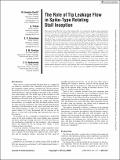THE ROLE OF TIP LEAKAGE FLOW IN SPIKE-TYPE ROTATING STALL INCEPTION
Author(s)
Hewkin-Smith, M; Pullan, G; Grimshaw, SD; Greitzer, EM; Spakovszky, ZS
DownloadPublished version (3.236Mb)
Terms of use
Metadata
Show full item recordAbstract
© 2019 by ASME. This paper describes the role of tip leakage flow in creating the leading edge separation necessary for the onset of spike-type compressor rotating stall. A series of unsteady multipassage simulations, supported by experimental data, are used to define and illustrate the two competing mechanisms that cause the high incidence responsible for this separation: blockage from a casing-suction-surface corner separation and forward spillage of the tip leakage jet. The axial momentum flux in the tip leakage flow determines which mechanism dominates. At zero tip clearance, corner separation blockage dominates. As clearance is increased, the leakage flow reduces blockage, moving the stall flow coefficient to lower flow, i.e., giving a larger unstalled flow range. Increased clearance, however, means increased leakage jet momentum and contribution to leakage jet spillage. There is thus a clearance above which jet spillage dominates in creating incidence, so the stall flow coefficient increases and flow range decreases with clearance. As a consequence, there is a clearance for maximum flow range; for the two rotors in this study, the value was approximately 0.5% chord. The chordwise distribution of the leakage axial momentum is also important in determining stall onset. Shifting the distribution toward the trailing edge increases flow range for a leakage jet dominated geometry and reduces flow range for a corner separation dominated geometry. Guidelines are developed for flow range enhancement through control of tip leakage flow axial momentum magnitude and distribution. An example is given of how this might be achieved.
Date issued
2019Department
Massachusetts Institute of Technology. Gas Turbine LaboratoryJournal
Journal of Turbomachinery
Publisher
ASME International